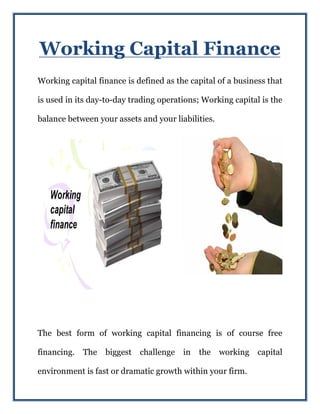Working Capital Finance
- 1. Working Capital Finance Working capital finance is defined as the capital of a business that is used in its day-to-day trading operations; Working capital is the balance between your assets and your liabilities. The best form of working capital financing is of course free financing. The biggest challenge in the working capital environment is fast or dramatic growth within your firm.
- 2. Types of Working Capital Finance Bank Overdraft Facility or Credit Line Short-Term Loans Accounts Receivable Loans Factoring or Advances Trade Creditor Equity Funding via Personal Resources or Investors Advantages Speed and Flexibility Maintain Ownership No Interest Self Reliance Growth of your business
- 3. Working capital financing is the main activity for the entire upcoming industry. It lends a hand to maintain your business in progress and aggressive in the commercial market. Managing working capital can be a complex process and involves keeping track of cash, inventory, debtors, and short-term financing. Each of these aspects is monitored within a short-term window in order to maximize return on capital. For more information please visit http://www.capitalaccess.net.au/



